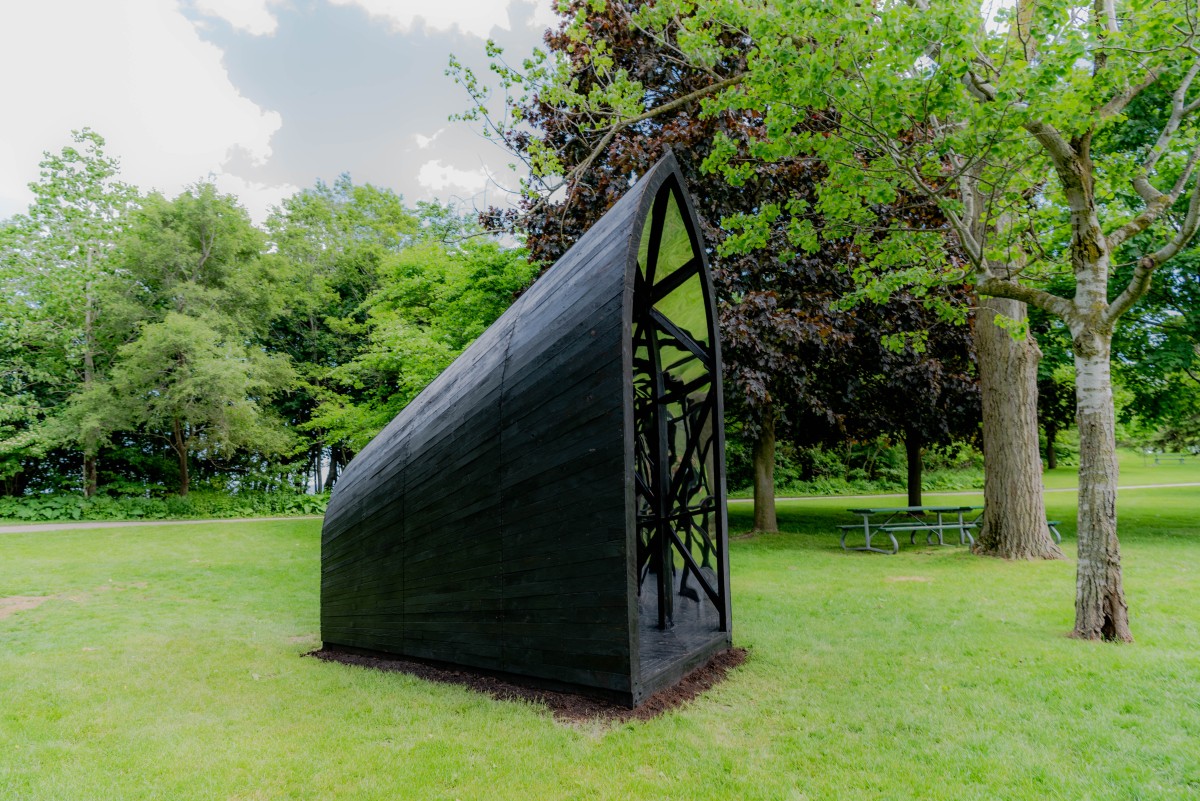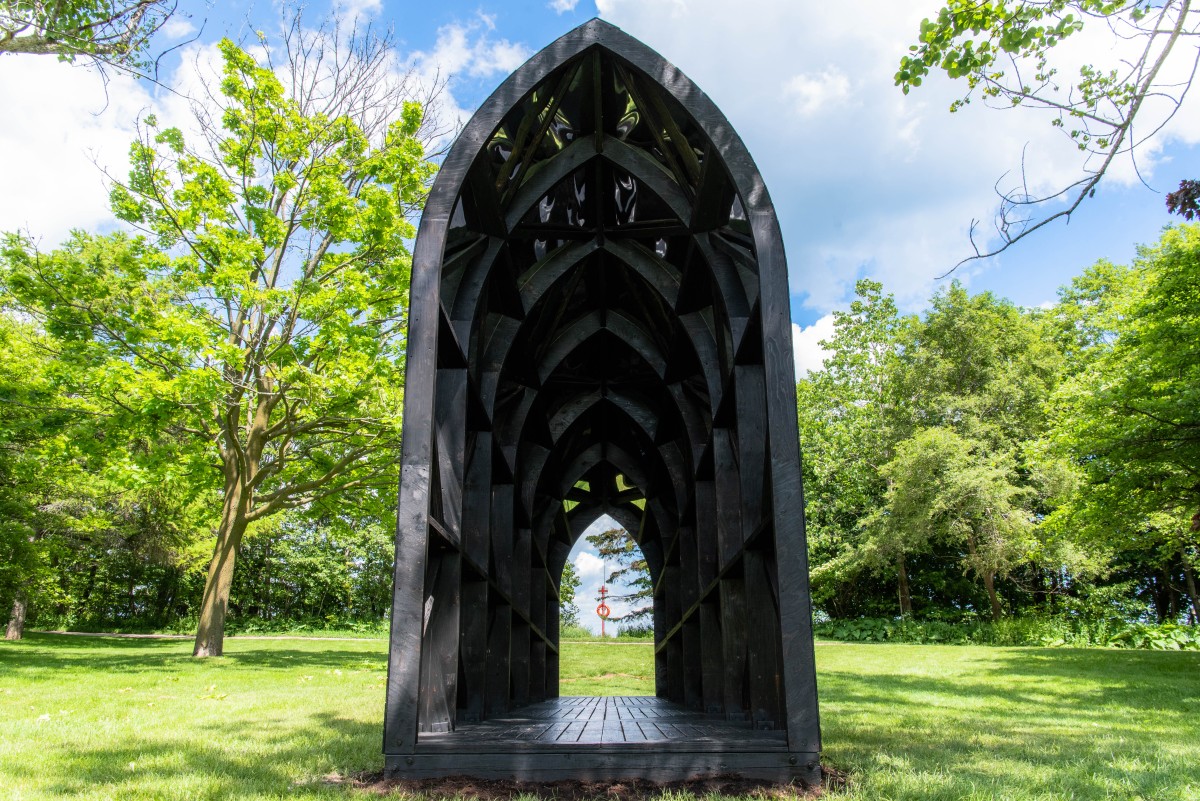Ark of veneration
We spoke with Nigerian-Canadian artist Oluseye Ogunlesi about his towering work of public art and ancestral veneration, Black Ark – on view now in Ashbridges Bay Park.
Black Ark (2022). Photo by Cassandra Popescu.
Nigerian-Canadian contemporary artist Oluseye Ogunlesi spent three years collecting shattered and discarded side-view mirrors from cars. For him, they are a metaphorical representation of Africans who were sold into slavery in exchange for mirrors during the Trans Atlantic slave trade. After journeying to Nova Scotia to study Black Canadian history, then to Senegal and the Ivory Coast to observe African Architecture, Ogunlesi’s culminating vision for his collection of car mirrors was born.
Black Ark (2022) is a towering 12-foot aluminum and burnt wood structure, installed in the open green space of Toronto’s Ashbridges Bay Park. Ogunlesi envisions the structure as a sacred memorial vessel to house his mirrors, and to pay reverence to ancestors whose lives were forever changed by enslavement. Black Ark’s striking burnt wood exterior references beachside homes Ogunlesi observed in the Ivory Coast, and its intricate mirrored interior is designed to give off a fragmented reflection for visitors entering the structure. This powerful work of public art is funded by Artworx TO and the Luminato Festival.
We recently connected with Oluseye Ogunlesi to find out more about Black Ark, and the dedicated foraging, travelling and researching it took to create it.
AGOinsider: Some of the core reference/inspirational objects you used in the creation of Black Ark were shattered side-view mirrors from cars. Can you explain the significance of these objects and what they represent for you?
Ogunlesi: A few years ago, I began collecting shattered side-view mirrors as a metaphor for Africans who were sold into slavery in exchange for mirrors, and whose lives were interrupted and forever changed. I dreamed of creating a vessel, a memoriam, to house all of these mirrors as an act of ancestral veneration. The mirrored interior of Black Ark is inspired by this collection of shattered mirrors and its function is to insert the viewer into the history of slavery in Canada, reflecting how we are either complicit or implicated in its legacy. So much of what we enjoy now was made possible by the labour and loss of life endured by enslaved people.
AGOinsider: So much of your creation and research process for this piece involved travel. Can you share a few significant moments/findings from your time throughout West Africa, in Nova Scotia and/or elsewhere?
Ogunlesi: My time in North Preston, Nova Scotia, is what led me on this trajectory of exploring Black Canadian history. Here, I was fortunate to meet a gentleman, Pastor Al, and through him, I learned about the exodus of 1792 which saw almost 2,000 free Blacks sail from Halifax to Freetown, Sierra Leone to start a new life. Alongside this, I’d also discover that over 60 of the ships used in the slave trade were in fact built on Canadian soil. I set out to build a structure that referenced this two-way migration of Blacks, as enslaved people and free people, as both legacies of slavery in Canada − this is why Black Ark has two access points.
All of the aesthetic choices were informed by my research trips in West Africa. The triangular pattern on the interior is inspired by the intricate wooden ceilings of the Diola people of Senegal and I got the idea for the burnt black exterior after seeing a cluster of beachside homes in Ivory Coast that had been stained black with a diesel sediment. By referencing African architecture, Black Ark is a symbolic home, a haven that commemorates the migration and survival of Black people, Black culture and Black imagination across time, space and place.
AGOinsider: Black Ark is a towering 12-foot structure that is physically open to the public. What are your hopes for how visitors will engage with the piece? (As the creator of the work, what does the ideal visitor response – physically and conceptually – to Black Ark look like for you?) Follow up question: In your opinion, why is public art important, in comparison to work in a gallery setting?
Ogunlesi: Ideally, I’d like people to interact with Black Ark before knowing what it’s about. I’d like them to engage with the playfulness of the structure: its fragmented reflective interior; its two-entry points, one of which shrinks to five feet and requires you duck down; the hollowing of the structure and its disorienting effect on the senses. Embodied in the structure’s playfulness are some of the violent realities of life aboard a slave ship.
The general consensus is that Toronto’s public art is lacking meaningful work, and as a result we’re missing out on opportunities to educate the public and help fill in the gaps where our educational systems fail us. I think Black Ark is a good example of how artists, with proper funding, can activate the city while creating opportunities for us to congregate, reflect and learn. In only a month, I’ve seen the impact that Black Ark has had and how many more people know about the long history and contributions of Black people in this country. Black Ark has presented us an opportunity to look back (at our history) and look forward to new possibilities.
AGOinsider: What is next on the horizon for Oluseye? Any projects, ideas or upcoming shows you can share with us?
Ogunlesi: In the fall, I’ll be headed back to West Africa to continue developing my Eminado series, a collection of over 250 palm-size assemblages that uses discarded materials from West Africa and the diaspora to reimagine the amulets carried by Africans on past and present voyages across the Atlantic. I am anchoring this work in the history of Friendship, a Canadian-built slave ship which took 208 Africans from present-day Nigeria to Montego Bay, Jamaica. Specifically, I’ll be working with a fourth-generation foundry in Benin City to transform and scale-up some of these talismans into monumental bronzes.
I’ve got other exciting projects for 2023 but I’d like them to spring up, from the ground, unexpectedly and urgently, like Black Ark.
Black Ark is on view in east Toronto’s Ashbridges Bay Park until September 5. Subscribe to the AGOinsider for more stories and art news, delivered each week to your inbox.


